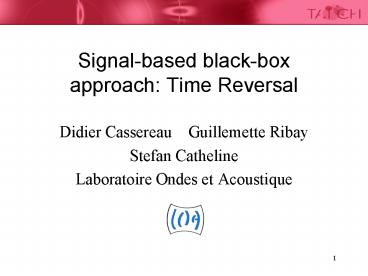Signalbased blackbox approach: Time Reversal PowerPoint PPT Presentation
1 / 12
Title: Signalbased blackbox approach: Time Reversal
1
Signal-based black-box approach Time Reversal
- Didier Cassereau Guillemette Ribay
- Stefan Catheline
- Laboratoire Ondes et Acoustique
2
Alternative method Time-Reversal
- Situations where physical parameters are not
known - Complex geometries and non flat objects
(simulation impossible) - Highly reverberant media
- Time reversal of Lamb waves does not require any
particular knowledge
3
Time-Reversal / Cross-correlation
Using step of the localization method
P
Cross-correlation
Conclusion the correlation method is equivalent
to time reversal in the computer
4
Signal Processing - Basic principles
Temporal signals 1/2
Fourier transforms 1/2
- Improvement of the
- cross-correlation
- method
- noise reduction
- phase extraction
threshold
5
Signal Processing - Basic principles
- extraction of the phase, for frequencies where
spectrum - modulus is above threshold
6
Signal Processing - Basic principles
- Phase correlation with references channel 1
- Phase correlation with references channel 2
- Average correlation coefficient between impact
and references - Identification of the best average correlation
- Localisation of the impact
7
Signal Processing - Influence of the impact
- Difficulty
- Learning mode / regular mode
- The impact may be different between these two
modes - Reliability of recognition is reduced
- Typical example learning mode using a metallic
object, and regular mode using fingers
8
Signal Processing - Influence of the impact
9
Signal Processing - Influence of the impact
- Only the information from the medium itself
remains - Phase-correlation with references
- No phase shift between impact and references
- The inverse Fourier transform is no more needed
- Improvement of the computation speed
10
Main theoretical results
- Time reversal spatial resolution
- Only one wave involved A0 Lamb wave
- The thinner the plate, the better the spatial
resolution - - Influence of the temperature
- Numerical simulation using a finite
- difference scheme experiments
- Stretching of the spectrum
- Same coefficient everywhere
- in the plate
- Can be compensated in real time
11
Experiment in a Plexiglas plate
Blue plus signs correlation coefficient of the
response at TC with the response
at 42C Red crosses correlation coefficient of
the response at TC after appropriate
stretching, with the response at 42C
12
Numerical simulations
- Useful tool to understand the physics of the
propagation - in thin plates
- Future objective replace the learning step when
a large - number of references is needed
- Complete numerical scheme that integrates
- Dispersion
- Reverberation
- Border effects and evanescent waves
- Diffraction

